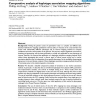Free Online Productivity Tools
i2Speak
i2Symbol
i2OCR
iTex2Img
iWeb2Print
iWeb2Shot
i2Type
iPdf2Split
iPdf2Merge
i2Bopomofo
i2Arabic
i2Style
i2Image
i2PDF
iLatex2Rtf
Sci2ools
BMCBI
2006
2006
Comparative analysis of haplotype association mapping algorithms
Background: Finding the genetic causes of quantitative traits is a complex and difficult task. Classical methods for mapping quantitative trail loci (QTL) in miceuse an F2 cross between two strains with substantially different phenotype and an interval mapping method to compute confidence intervals at each position in the genome. This process requires significant resources for breeding and genotyping, and the data generated are usually only applicable to one phenotype of interest. Recently, we reported the application of a haplotype association mapping method which utilizes dense genotyping data across a diverse panel of inbred mouse strains and a marker association algorithm that is independent of any specific phenotype. As the availability of genotyping data grows in size and density, analysis of these haplotype association mapping methods should be of increasing value to the statistical genetics community. Results: We describe a detailed comparative analysis of variations on our ma...
Related Content
| Added | 10 Dec 2010 |
| Updated | 10 Dec 2010 |
| Type | Journal |
| Year | 2006 |
| Where | BMCBI |
| Authors | Phillip McClurg, Mathew T. Pletcher, Tim Wiltshire, Andrew I. Su |
Comments (0)

